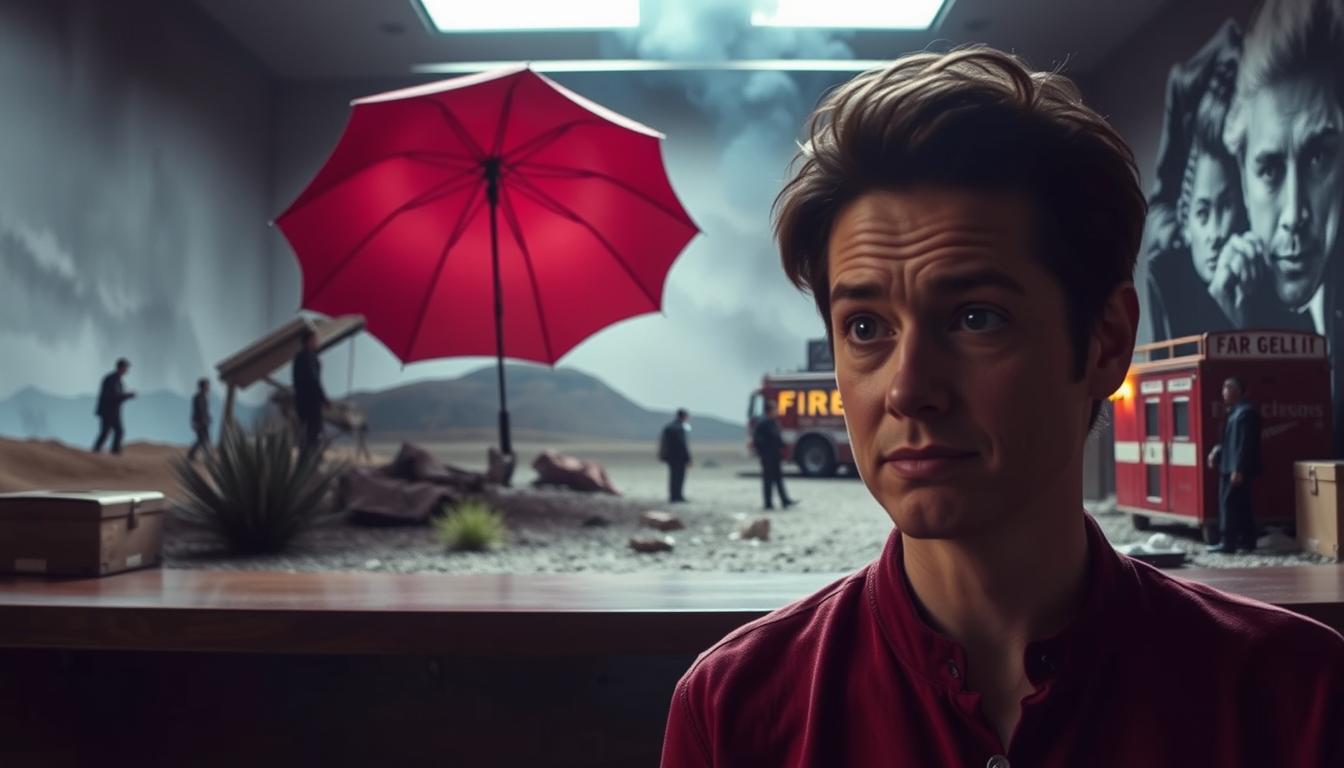Physical Address
304 North Cardinal St.
Dorchester Center, MA 02124
Physical Address
304 North Cardinal St.
Dorchester Center, MA 02124

Welcome to your guide for understanding irony, a tool that shapes stories, jokes, and even everyday interactions. From ancient Greek plays to viral social media posts, this concept reveals hidden truths by contrasting expectations with reality. Let’s unpack its layers together.
The roots of irony stretch back to 5th-century Greece, where clever characters pretended ignorance to outsmart rivals. This “eiron” archetype laid the groundwork for how we recognize contrasts between appearance and truth today. Over centuries, irony evolved beyond theater into philosophy, literature, and casual conversation.
Modern irony isn’t just about sarcasm or plot twists. It’s a lens for examining life’s contradictions—like rain during a picnic you’ve planned for weeks. By spotting these contrasts, you’ll gain fresh perspectives on everything from classic novels to awkward family dinners.
At its core, irony thrives on the unexpected twists between intention and outcome. This linguistic device shapes conversations, stories, and even cultural movements by highlighting gaps between expectations and reality. Let’s explore why this concept remains so vital across centuries.
Irony acts like a secret handshake in language. It builds connections between those who grasp the hidden meaning, while leaving others puzzled. Think of inside jokes at family gatherings or sarcastic tweets that go viral—these moments create shared understanding among specific groups.
This dual nature makes it powerful. Writers and speakers use it to critique society subtly, while comedians employ it to expose life’s absurdities. The real magic happens when audiences decode both surface-level statements and their deeper implications.
Originally appearing in Greek comedies, irony evolved into a tool for philosophers like Socrates. By pretending ignorance, he exposed flaws in others’ arguments—a technique still used in debates today. Over time, it spread through literature, theater, and now digital media.
Henry Watson Fowler noted in 1906 that all definitions must acknowledge the contrast between stated and intended meanings. This paradox explains why the term resists simple explanations—it’s designed to mean two things at once.
This literary device thrives on layered contradictions. Experts like Douglas C. Muecke describe it as a “two-story” phenomenon where surface statements mask deeper truths. The magic happens when audiences spot the gap between literal words and their true intent.
Imagine shouting “Perfect day for a picnic!” during a thunderstorm. This classic example shows how verbal irony works—the stated meaning clashes with reality. As Wayne Booth noted, this double-layered approach makes it a powerful rhetorical tool for humor or critique.
In conversations, irony lets us say “Nice job!” when someone spills coffee, softening criticism with humor. Authors use it differently—think of a detective trusting the story’s actual villain. This “innocence” element keeps readers engaged as they uncover hidden truths.
| Context | Purpose | Example |
|---|---|---|
| Daily Conversations | Social bonding through humor | “Love getting stuck in traffic!” |
| Literature/Film | Revealing plot twists | Romeo unknowingly poisoning himself |
| Cultural Commentary | Highlighting contradictions | Satirical news headlines |
Whether in books or banter, irony’s power lies in its dual nature. It challenges us to look beyond obvious statements and discover richer meanings beneath the surface.
Language’s hidden gems shine brightest when we dissect their three primary forms. Each creates distinct effects through mismatched expectations, but their mechanics vary dramatically. Let’s explore how these types operate across conversations and narratives.

Verbal irony dances on the tightrope between words and meaning. Imagine a friend arriving soaked in rain declaring, “Lovely weather we’re having!” The statement’s literal meaning clashes with reality, creating that signature wink-of-the-eye effect.
Unlike sarcasm’s sharp edges, verbal irony can be playful or even kind. Teachers might say “Wow, quiet class today” to giggling students—a gentle nudge rather than mockery. This flexibility makes it a social lubricant in daily interactions.
Dramatic irony turns audiences into fortune-tellers. In horror films, you scream at characters approaching dark basements—you know the danger they ignore. This knowledge gap builds suspense as viewers anticipate outcomes hidden from the cast.
Situational irony delivers reality’s plot twists. Fire stations burning down or diet coaches gaining weight—these contradictions between expectation and result highlight life’s unpredictability. It’s the universe’s way of keeping us humble.
| Type | Key Feature | Common Use |
|---|---|---|
| Verbal | Contrast between said and meant | Casual conversations, humor |
| Dramatic | Audience knows more than characters | Thrillers, tragedies |
| Situational | Outcome contradicts expectations | Life events, twist endings |
Recognizing these different types helps decode everything from Shakespearean tragedies to viral memes. While they share a foundation of contradiction, each serves unique storytelling and communicative purposes.
Stories come alive when contradictions dance across the page. This literary spice turns predictable plots into unforgettable journeys, revealing truths through unexpected twists. Let’s explore how masters of storytelling use this tool to grip audiences and mirror life’s strange coincidences.

Shakespeare’s Romeo and Juliet thrives on layered contradictions. The lovers meet at a party hosted by their family’s enemies, unaware their passion will seal both clans’ fates. When Romeo believes Juliet lies dead, his desperate act becomes the ultimate example of tragic miscommunication.
Flannery O’Connor’s short story “A Good Man Is Hard to Find” delivers brutal situational twists. A grandmother’s frantic warnings about a murderer ironically lead her family into his path. Her attempts to avoid danger become the catalyst for disaster—a reminder that conflict often arises from good intentions gone awry.
These real-world parallels show how storytelling techniques echo life’s unpredictability. Writers sharpen narratives by letting outcomes clash with expectations, while audiences relish the thrill of uncovering hidden truths.
Ancient philosophers mastered irony as a tool for enlightenment and connection. This device thrives when speakers and listeners share cultural touchstones, transforming simple statements into layered exchanges. At its best, it builds bridges between minds while exposing societal contradictions.
Socrates famously played naive to reveal others’ flawed logic. His method—asking probing questions while claiming ignorance—forced students to confront their own gaps in understanding. This approach wasn’t mockery but mentorship in disguise, guiding Athenians toward self-discovered truths.
Effective use of this technique requires three shared foundations:
When these align, audiences become active partners in decoding messages. Comedians and politicians alike wield it to critique norms without direct confrontation, creating “in-groups” through shared recognition.
This collaborative aspect explains why sarcasm strengthens friendships but confuses outsiders. Like solving a puzzle together, successful irony turns communication into an intellectual handshake—rewarding those who grasp the hidden layers.
Irony’s reach extends into the realms of fate and authorship. While everyday forms focus on immediate contradictions, these deeper types of irony explore humanity’s relationship with larger forces—whether cosmic or creative.
Cosmic irony shows life’s plans crumbling under indifferent universes. Thomas Hardy’s novels master this form of irony—farmers lose crops to sudden storms, lovers miss connections by minutes. These aren’t mere plot devices but reflections on our fragile control over destiny.
Romantic irony turns writers into puppet masters. Friedrich Schlegel championed this approach, where authors interrupt stories to remind readers of their power. Imagine a narrator stopping mid-scene to discuss plot choices—it transforms passive reading into active dialogue between creator and audience.
Both forms reveal how storytelling mirrors life’s unpredictability. Whether through cosmic jokes or authorial winks, they challenge us to question who—or what—holds the pen.